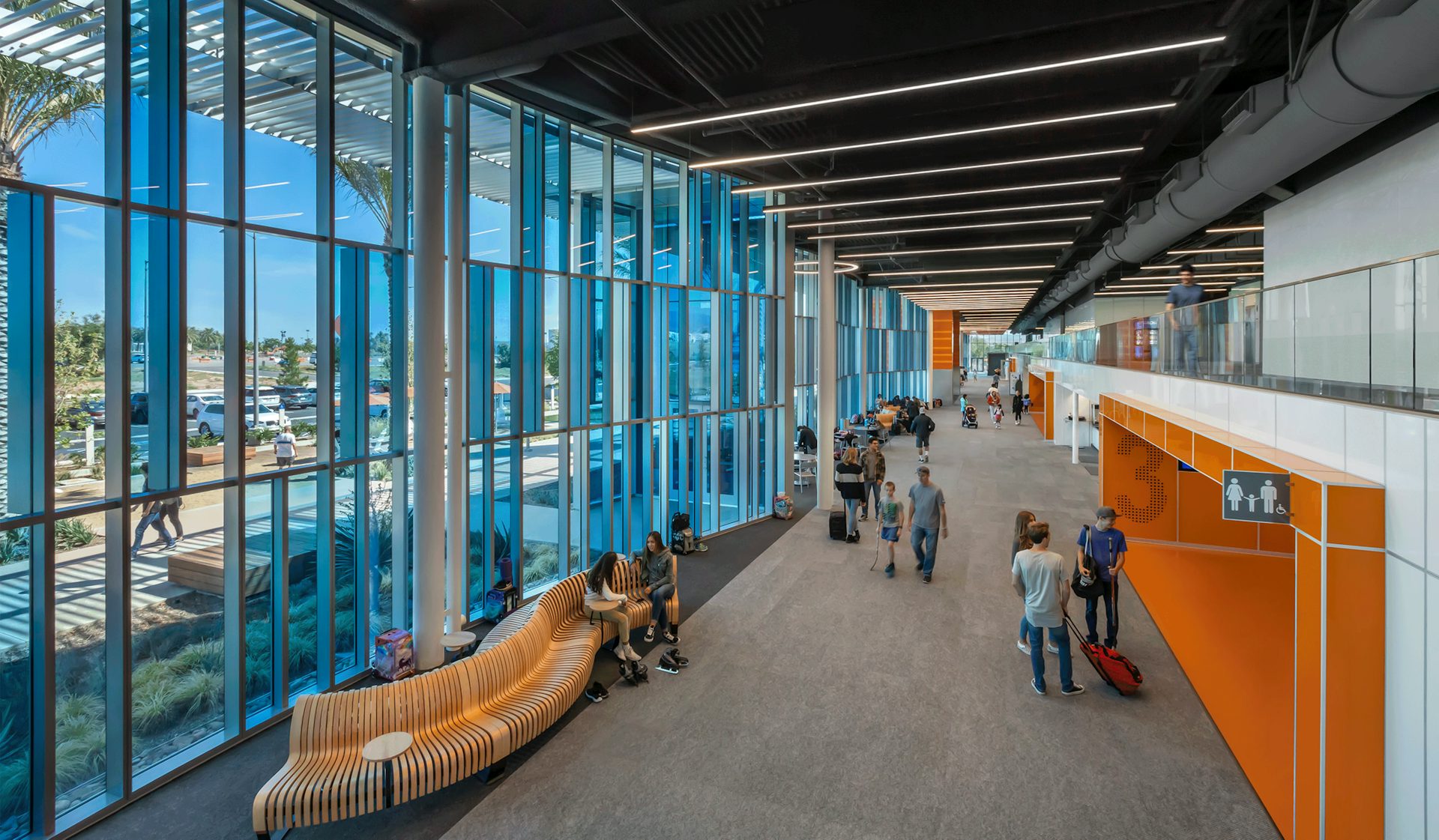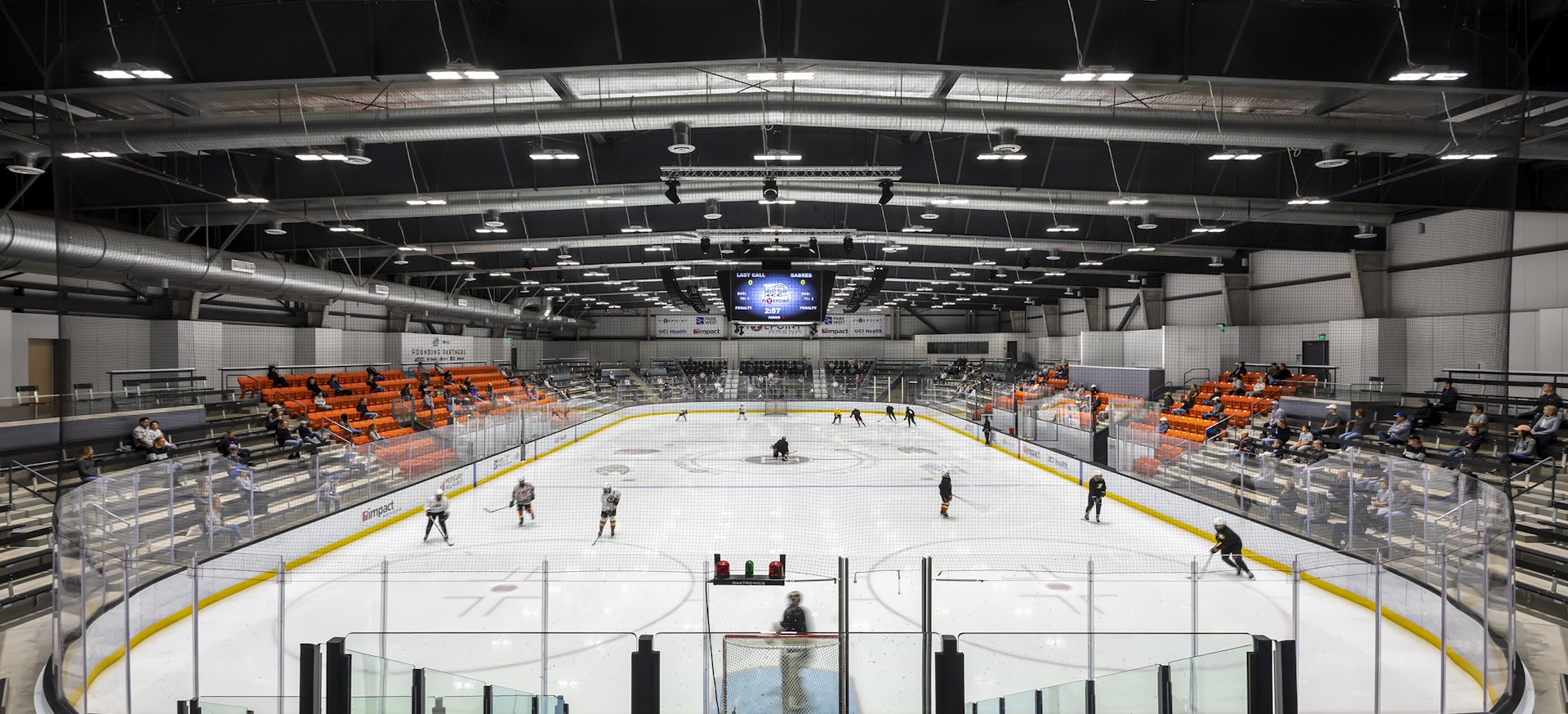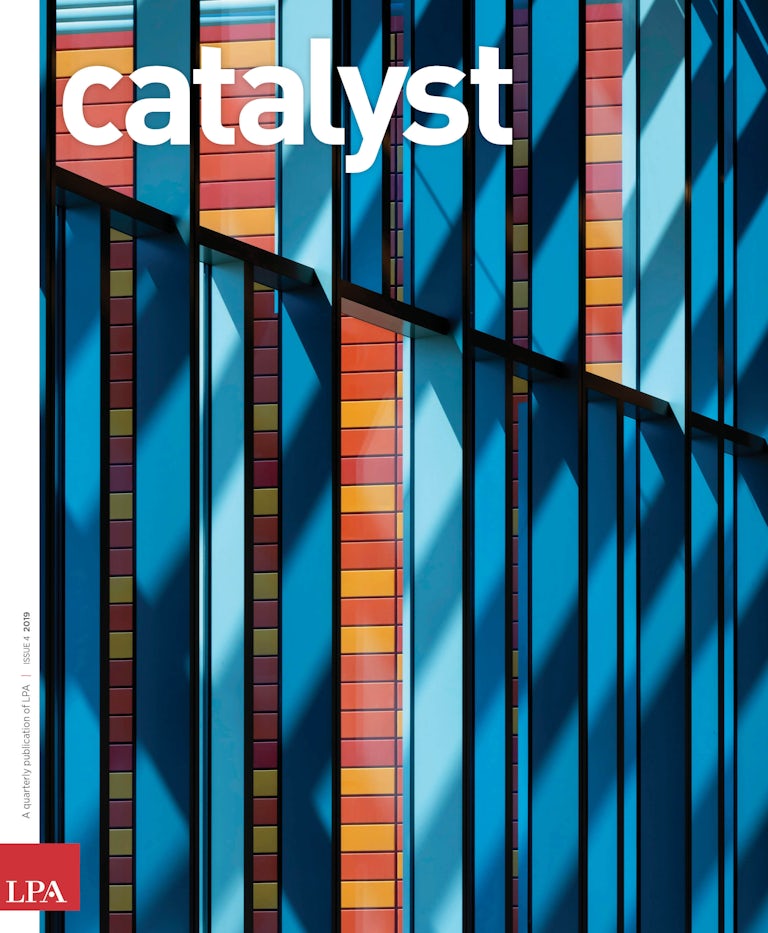On a bright, sunny Southern California afternoon, kids with skates and hockey sticks scamper through a landscaped park. Their destination is the Great Park Ice and FivePoint Arena, a 270,000-square-foot ice-sports-focused community center, which opened this spring in Irvine as one of the largest neighborhood ice skating facilities in the country. As they enter through the glass façade, the kids run to one of four ice sheets in the facility, which also serves as the training center for the Anaheim Ducks of the National Hockey League and the home of the U.S. Figure Skating team.
Dubbed the “Taj Mahal” of skating facilities by U.S. Figure Skating executive Mitch Moyer, Great Park Ice merges the vibe of a Southern California park—palm tree-lined walkways and a 3,500-square-foot sandy beach—with a state-of-the-art ice center, restaurants, retail space, private facilities for the Ducks and an arena with 2,500 seats.
Ducks Vice President Art Trottier, who oversees the team’s rinks operations, has seen the impact the $108 million facility has on visitors when they explore and experience the complex for the first time. “You can see how impressed people are,” Trottier says. “There’s nothing like this in Southern California.”
In a region better known for soccer, surfing and beach volleyball, Great Park Ice creates a very California center for hockey and ice sports, following the aspirations of Ducks owners Henry and Susan Samueli. The project was developed by the Irvine Ice Foundation, a nonprofit group the couple established to promote ice sports in the community. In 50 years, full ownership of the facility will be turned over to the city.
“From the beginning, we knew this was going to be special for the community,” says LPA Principal Steve Flanagan.
So Cal Ice
New facility creates an energy-efficient, large-scale community skating facility in a desert environment, as well as a training center for the Anaheim Ducks and U.S. Figure Skating.

A NEW TYPE OF ICE CENTER
At their heart, most ice facilities are designed for cold-climate communities. “The typical ice facility is a sea of parking and a front door and that’s it,” Flanagan says. “You get out of your car, you run as fast as you can and you get in the building and you start ice skating.”
There are ice rinks throughout California—including the Ducks’ former training center, Anaheim Ice, which was designed by Frank Gehry—but they tend to be simple, utilitarian facilities. Beyond a concession stand and locker rooms, there are few amenities and little consideration for anything beyond giving kids a place to skate.
From the start, there were larger ambitions for the Great Park Ice facility, which is the centerpiece of a 688-acre greenbelt in a residential community on the site of a former Marine Corps Air Station. The 13.5-acre project was developed through a public-private partnership and planning process that included the City of Irvine, Griffin Structures, community developer FivePoint, Swinerton Builders and LPA. Several ice and arena specialists joined as collaborators, including ice facilities consultant 292 Design Group; mechanical engineering specialist Nelson Rudie & Associates; electrical engineering group TK1SC; and B32 Engineering, one of the country’s leading experts on ice-system engineering.
Involving the Ducks was always part of the plan, but designs were already in development when the facility was upgraded to the team’s primary training facility. The affiliation with U.S. Figure Skating developed further down the timeline. “All of a sudden, all these things started happening,” says LPA Senior Project Manager Steve Tiner.

The inclusion of the Ducks facility added many layers of complexity. Team members would need a secure, private entrance, as well as an array of training spaces and privacy to conduct their business outside of public view. The design would also need to be impressive enough to help recruit players to the team in the can-you-top-this environment of pro sports. “The whole idea is to attract talent,” Tiner says. “There had to be a ‘wow’ factor.”
Beyond the Ducks, the designers wanted to create a flexible space for the wide array of uses, while making the ice complex energy efficient in the warm climate. The logistics of the site, the orientation to the sun and the community goals played large roles in the initial design process. LPA’s integrated team included landscape architects and structural engineers, who looked for ways to blend the outdoors with the ice, while creating a building that could be built on a streamlined time frame.
But the designers were also diving into more complex, fundamental questions, including, “What should an ice facility be like in Southern California? Should it follow the model of facilities in the East? Or create something new?”
“We wanted to embrace the idea of ice in the desert environment,” recalls LPA Design Director Franco Brown. “We wanted the facility to feel like it is part of Southern California and this is the only place it could be.”

THE PHASES OF WATER
The design for the site allowed for 68,500 square feet of park space, which includes the sandy beach area, drought-resistant landscaping and an amphitheater for community events. The park fronts a 700-foot undulating transparent façade with a ripple of silver fins meant to mimic the surface of the ocean. LPA designers wanted the complex to reflect a visual representation of the different states of water—vapor, liquid and, ultimately, frozen. The outdoor spaces dissolve into the indoor spaces. The façade and the movement of people reflect the flow of water through the building; the hallways leading to the ice are bathed in blue light created by the façade. “It is the idea of a transition throughout the building,” Brown says.
The long lobby resembles a large airport terminal, with spots for people to hang out, warm up and stretch. The space includes a Ducks team store, a pro shop, a sports pub and concession stand, as well as access to a dry-land training facility. Individual hallways lead to each sheet of ice, which are aligned side-by-side. The 2,500-seat FivePoint Arena is at the east end of the facility, with its own entrance and ticket office.
“The key to an ice rink is the lobby and the lobby is so grand here,” Trottier says.
Working with LPA’s engineering team, the building was ultimately designed with two pre-engineered metal buildings, connected by a conventional structure for the lobby and offices. Creating the long spans for the ice arenas off-site sped up the construction process and created column-free spaces for the rinks, Flanagan says. “We were mindful of the budget and wanted to deliver the project as fast as possible, while maintaining the quality,” he says. The pre-engineered framework also supports insulated metal exterior panels that help create a thermal envelope to retain the temperature around each sheet and cut operating costs.

The orientation of the buildings moved the ice sheets away from the sun, allowing the lobby to become an open and bright space while preserving the cool temperature around the ice. “Basically, what you are doing is building a refrigerator around the ice, and that is exactly what we did here,” says Tom Betti, partner at 292 Design Group, one of the country’s leading consultants on ice facilities.
The environment around the ice is essential, with dangers ranging from permafrost to unwanted fog caused by inaccurately calibrated mechanical systems. “You get it wrong, and all kinds of bad things can happen,” Flanagan says. “It’s very sensitive.”
In addition to preserving the envelope around the ice, every aspect of the design looked to increase the efficiency and reduce the costs of operating the ice sheets, which are notorious water and energy hogs. The mechanical system reclaims water and a dehumidifier recycles heat generated by the system. An ammonia-based refrigeration system reduces greenhouse gas emissions. The materials used throughout the facility are recycled and sustainable. The result is a facility designed to operate 28 percent more efficiently than California’s Title 24 requirements, 42.5 percent with the addition of fuel cells.

MEETING THE GOALS
Ask people about their favorite part of the new facility and you will get a variety of answers. Betti points to the glass façade, which turns the ice facility into a bright and sunny place, where people on the outside can see what’s going on inside. Typically, ice facilities are inward looking, Betti says. He also likes the way people move through the building. “There is a very clear delineation of circulation,” Betti says. “It makes it very user friendly.”
Others point to the outdoor spaces that lead to the building, connecting the site to the local climate, including the grassy areas and the amphitheater, which can be used for community events. “I was surprised how much LPA took advantage of the outdoor space,” Trottier says.
A few months after the opening, the flexibility of the spaces is already apparent. Plans call for a wide variety of sports and events, including curling, short-track speed skating and sled hockey. There are also plans to host badminton, basketball and volleyball events. To accommodate U.S. Figure Skating, there is a room to practice ballet, a harness room to rehearse jumps and physical therapy facilities, clustered around the Olympic-sized rink with the lighting and staging infrastructure needed for national-scale events.
“I love the way it is operating,” Trottier says. Every day he sees people finding new ways to use the lobby for workouts, meetings and pre-practice rituals. “There are so many niches,” Trottier says. He’s also found some discovered some surprises. “The lighting at night looks phenomenal,” he says.
More than anything, the complex is fulfilling the goals set out by the Samuelis, creating a new center to help promote fitness and ice sports in the neighborhoods.
“I think it’s great for the hockey community, but it’s also great for the City of Irvine,” Trottier says. “This is a great investment for the community.”
This story originally appeared in Catalyst Issue 4 2019. Subscribe today to receive Catalyst, a quarterly publication that takes a deep dive into design ideas, industry leaders and initiatives.















